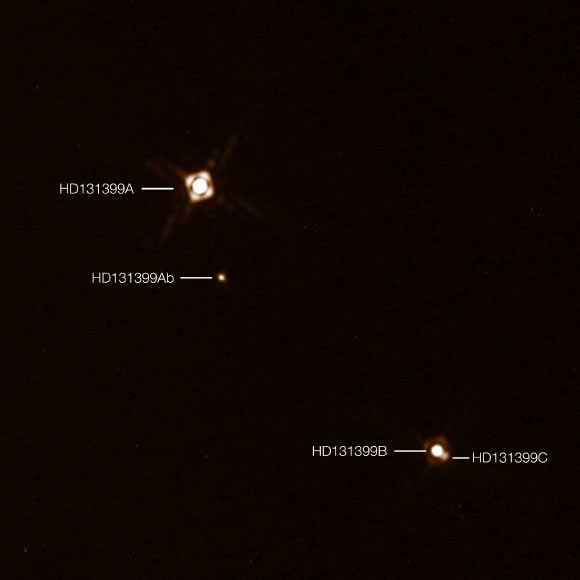The newfound alien world, named HD 131399Ab, resides in the HD 131399 system, about 320 light-years from Earth in the constellation of Centaurus.
Its orbit around HD 131399A, the brightest of the three stars, is by far the widest known within a multi-star system. Such orbits are often unstable, because of the complex and changing gravitational attraction from the other two stars in the system, and planets in stable orbits were thought to be very unlikely.
“The fainter two stars are always much closer together, and change in apparent separation from the brightest star throughout the year.”
The astronomers estimate that HD 131399Ab is at least four times as massive as Jupiter and has a surface temperature of around 1,076 degrees Fahrenheit (580 degrees Celsius).
The planet is approximately 16 million years old, making it also one of the youngest exoplanets discovered to date, and one of very few directly imaged planets.
“HD 131399Ab is one of the few exoplanets that have been directly imaged, and it’s the first one in such an interesting dynamical configuration,” said team member Dr. Daniel Apai, also from the University of Arizona.
“The fainter two stars are always much closer together, and change in apparent separation from the brightest star throughout the year.”
The astronomers estimate that HD 131399Ab is at least four times as massive as Jupiter and has a surface temperature of around 1,076 degrees Fahrenheit (580 degrees Celsius).
The planet is approximately 16 million years old, making it also one of the youngest exoplanets discovered to date, and one of very few directly imaged planets.
“HD 131399Ab is one of the few exoplanets that have been directly imaged, and it’s the first one in such an interesting dynamical configuration,” said team member Dr. Daniel Apai, also from the University of Arizona.
Although repeated observations will be needed to precisely determine the trajectory of HD 131399Ab, VLT observations and simulations seem to suggest the following scenario:
(i) HD 131399A is orbited by the less massive stars, HD 131399B and HD 131399C, at about 300 astronomical units (AU);
(ii) HD 131399B and HD 131399C twirl around each other like a spinning dumbbell, separated by a distance roughly equal to that between the Sun and Saturn (10 AU);
(iii) the planet HD 131399Ab travels around the host star HD 131399A in an orbit with a radius of about 80 AU, about twice as large as Pluto’s in the Solar System, and brings the planet to about one third of the separation between star HD 131399A and the HD 131399B/C star pair.
Sourrce; sci-news


No comments:
Post a Comment